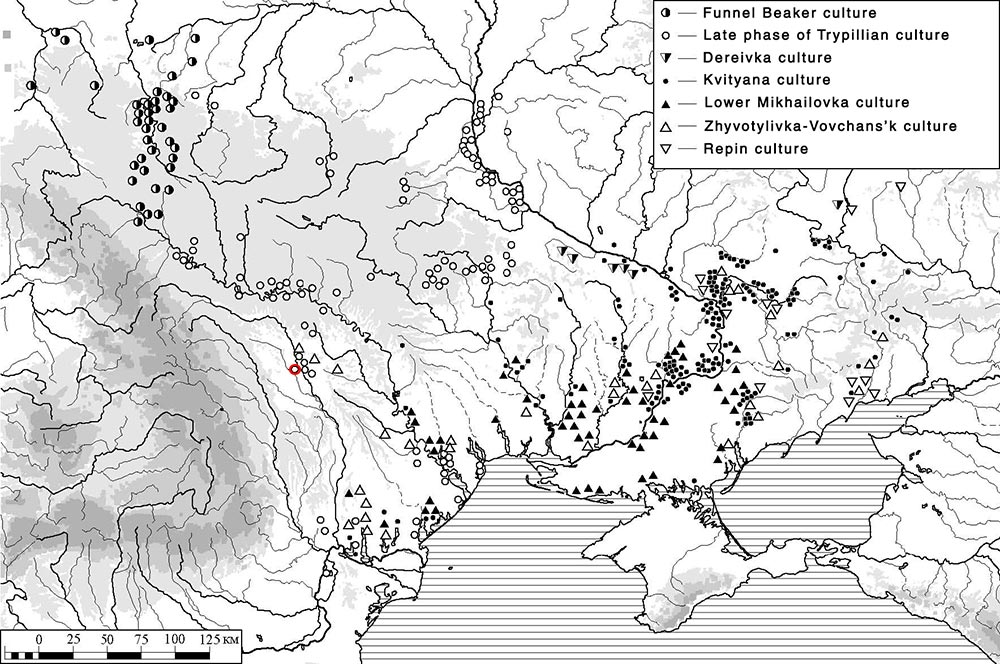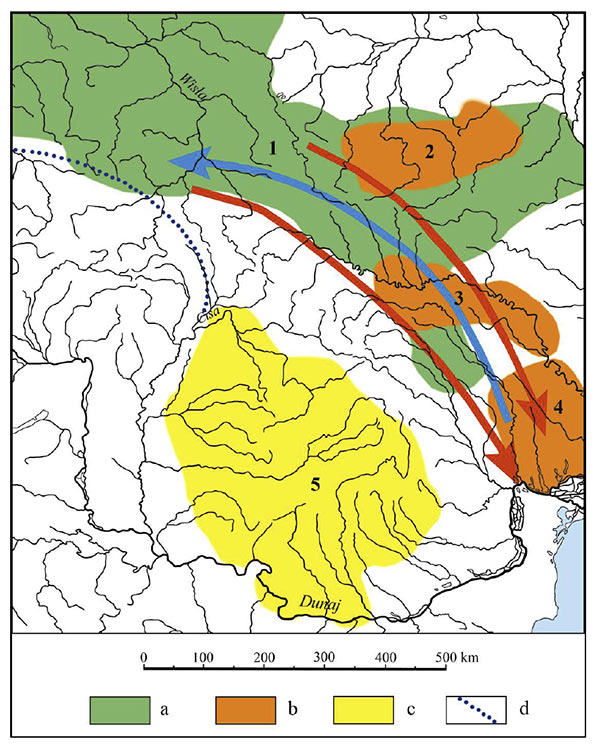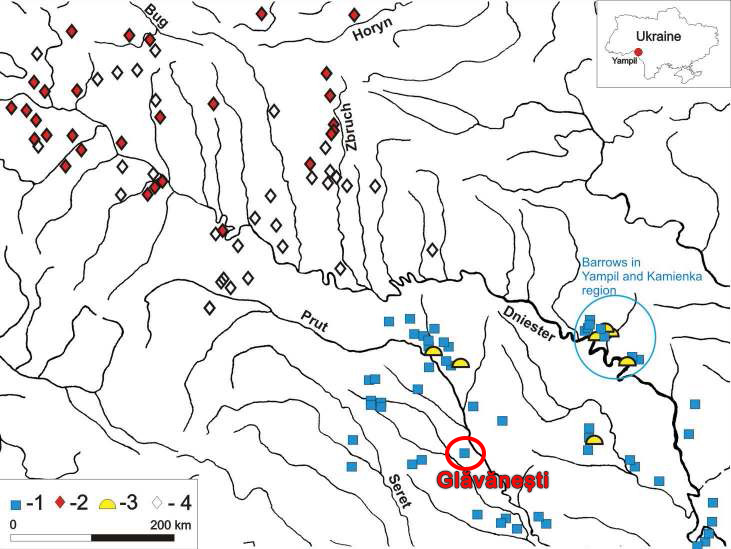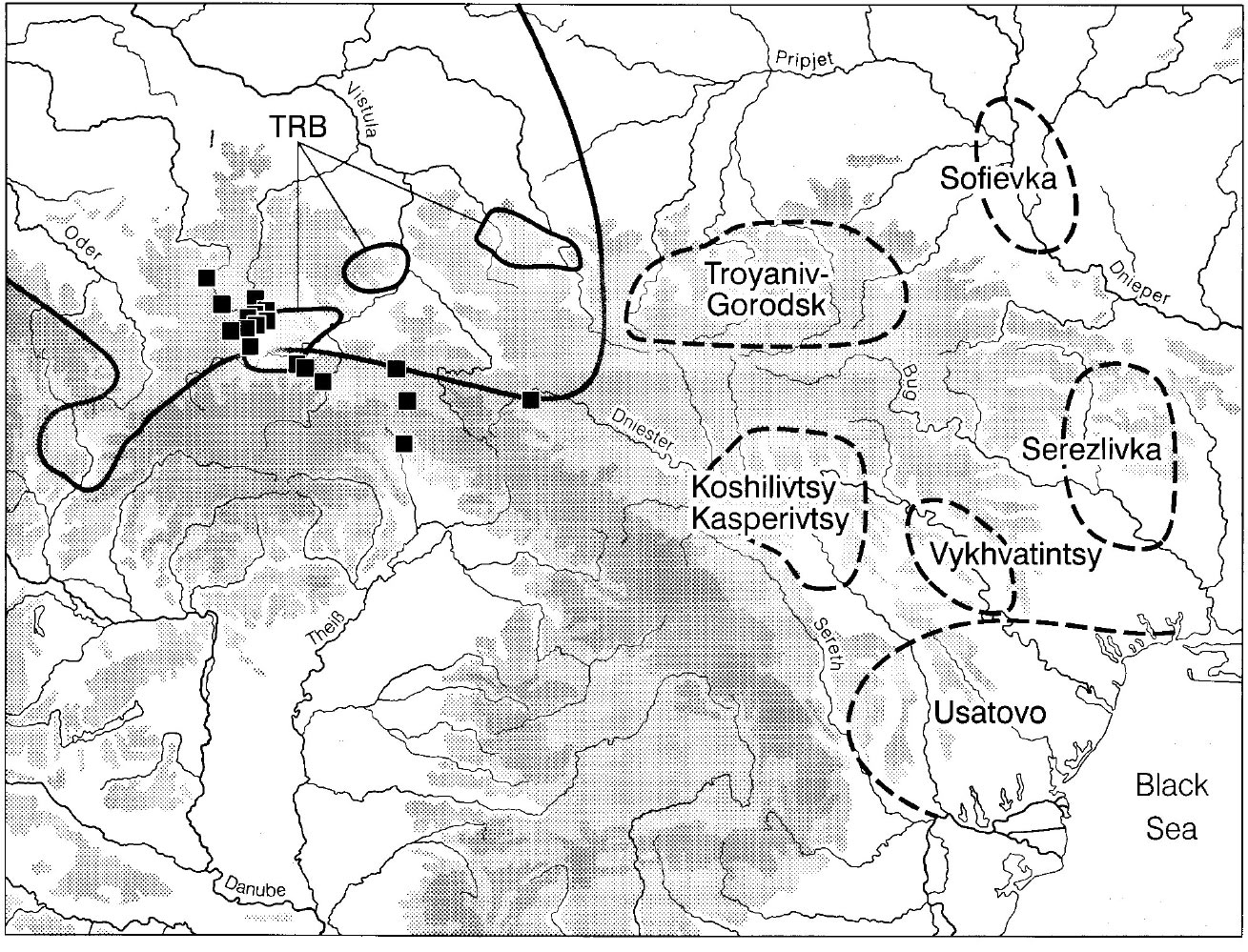Recently, the preprint by Sirak et al. biorXiv (2019), Human auditory ossicles as an alternative optimal source of ancient DNA, was published in Genome Res. (2020), and the corresponding samples were finally uploaded to ENA.
I have been trying to get my hands on sample GLAV_14, a male from the Late Eneolithic site Glăvăneştii Vechi, classified as Romania Bronze Age (ca. 3500-3000 BC), mtDNA T1a1, referenced as investigated first in the study:
Haas N, Maximilian K. 1958. Anthropological study of the human bones from graves with ochre from Glăvăneștii Vechi, Corlăteni and Stoicani Cetățuie. Soviet Anthropology 4, 133-146.

He turned out to be of haplogroup R1a-Z93, negative for Z94 and other archaic Z93 branches* (although not all are covered), suggesting that he might belong to a basal subclade, which questions even more the radiocarbon date of the downstream Z94 (Y3/Y26+) found in Alexandria (supposedly ca. 4000 BC):
*In ISOGG 2019 standard, it is R1a1a1b2 (xR1a1a1b2a, xR1a1a1b2d, xR1a1a1b2e1, xR1a1a1b2f, xR1a1a1b2g, xR1a1a1b2h1).
Admittedly, there is not much information on this Pre-Yamnaya period, and most of it is in Romanian (see e.g. here), but the burial probably belongs to an early stage of the Late Eneolithic, part of the earliest tumuli of Late Trypillian groups, although the site has also earlier archaeological layers.
This sample is yet another key to understand potential links of the common “Steppe ancestry” of Yamnaya and Corded Ware peoples after the complex population movements of Late Eneolithic groups in the North Pontic area.

a – Globular Amphorae culture;
b – Late Trypillia (1), Gorodsk (2), Vykhvatintsy (3) and Usatovo (4) groups of Trypillia culture;
c – Coţofeni culture; d – northern border of the late phase of Baden culture;
red arrows – direction of Globular Amphora culture expansion;
blue arrow – direction of „reflux” of Globular Amphora culture
(apud Włodarczak, 2008, with changes).
#EDIT (13 MAR 2020): A similar SNP inference can be made of Balkans Middle Bronze Age sample I2163, from the Kairyaka necropolis, Merichleri (ca. 1750-1625 calBCE):
In ISOGG 2019 standard, it is R1a1a1b2 (xR1a1a1b2a, xR1a1a1b2d, xR1a1a1b2e1, xR1a1a1b2f, xR1a1a1b2g, xR1a1a1b2h1).
Lacking more detailed archaeological information, and based on the genomic differences with previous EBA samples of the same site, I have always thought that it must have been a Srubnaya-related individual from the Noua–Sabatinovka–Coslogeni complex, mainly because of its elevated Steppe-related ancestry (see e.g. here).
However, it is possible that it represents a remnant of previous migrations, hence a resurged Old European haplogroup, just like those I2a or J2 integrated among Palaeo-Balkan-speaking peoples, but showing admixture with Coslogeni individuals. The location of modern basal R1a-Z93* and archaic R1a-Z93 samples in Europe visible on YFull might give more support to that option.
On the other hand, Srubnaya shows a high haplogroup variety, with different R1a1a1b2a-Z94 subclades (possibly including the Alexandria R1a1a1b2a1
-Y3*), as well as R1a1a1b2e, R1a1a1b2h, and also two R1a1a1b1a2 (Z280+) samples, so the most plausible option right now is to assume that Pokrovka was a source of Z93 bottlenecks very much like Sintashta-Potapovka-Filatovka and their predecessor in the forest-steppe, Abashevo.

Replaced by the Yamnaya
This is the information we have about burials from the same site during the Yamnaya period, some centuries later, by Frînculeasa et al. (2013):
- Dates for tumuli from Ukraine and especially Western Yamnaya suggest an interval of ca. 3100 – 2500 BC.
- A Yamnaya Glăvăneştii burial (1/11) shows some pieces of adornment containing 1.55% and 3.4% tin, which points to an early chronological time frame.
- The area is one of graves lined and covered with wooden beams, as in the Yampil Complex.
- Ornaments made of mammal teeth connect it with the entire Yamnaya area, including south of the Danube, but also with Catacomb graves. Similar pieces occur in Eneolithic graves from the north Pontic area, such as Late Trypillian graves from Giurgiuleşti and Usatovo, but also in plane cemeteries or tumuli from Central Europe.

Yamnaya horse riders
Interestingly, the University of Helsinki recently announced a key paper by Volker Heyd on Yamnaya Romania that PNAS will publish soon, although it is unclear which settlements exactly the abstract refers to:
The First Rider: Osteological Evidence for Earliest Horsemanship in a Yamnaya-related burial from Romania.
One of the most striking features of the Late Neolithic/ Early Bronze Age Yamnaya Culture from the North Pontic steppe area is the speed and extent of spread of its cultural and genetic “package” during a few centuries around 3000 BC.
While even a group of people walking on foot can migrate respectable distances, the exceptional success of Yamnaya groups seems difficult to explain that way. The use of horses for transport would certainly support a migration model; but so far, we do not have reliable clues for that. Now, the examination of Yamnaya-related human skeletons from Romania yielded findings that may be considered proof not only for casual, but regular use of horses as mounts by these early steppe herders spreading to the west.
Sounds familiar? Indeed, because early East Bell Beakers show similar proof of regular use of horses as mounts, which adds to their evident direct connection with the radical expansion of the R1b-L23-rich Yamnaya (see e.g. Olalde et al. 2018 Suppl. Materials).
None of this is surprising at this point, because we already have genetic evidence of the origin of the first expansion of domesticated horses with the Yamnaya into the East Bell Beaker breeds.
Fulfilled predictions
You can see in my writings that I have predicted the origin of R1a-M417 (and R1a-Z645) bottlenecks in the Dnieper-Dniester corridor in early 2017, and in recent years more specifically in the Podolian-Volhynian Upland (see e.g. here).
My latest comment in that regard came just days ago, illustrated with the use of phylogeny and geography of the ancient R1a samples known to date. This is an updated version of the map, including all R1a-M417 samples from ca. 3500-2000 BC:
The Origins of the Corded Ware culture
So, how does this affect the future of the Steppe ancestry concept and the “Indo-European Corded Ware” controversy?
Before the report of the (questionable) Eneolithic sample from Alexandria in 2017, I was convinced that the Steppe ancestry proper of the Yamnaya appeared among some early Corded Ware samples due to admixture through female exogamy, hence the close similarity of the then available Latvia Late Neolithic female to the Yamnaya cluster.
NOTE. This similarity can now be extended to other reported early CWC males of hg. R1a-M417 from the Baltic and, more recently, early CWC Poland.

After the first report of the Alexandria individual, and especially after the publication of earlier samples from different cultures showing Steppe ancestry in Wang et al. (2019), this explanation was not needed anymore, because different Steppe-related mating networks could have coexisted for centuries more or less independently throughout the Pontic-Caspian steppes and forest-steppes (see a recent full account of Steppe ancestry evolution).
Surprisingly, though, Kristiansen et al. (2017) is now interpreted by Frînculeasa (2019) as agreeing with that concept of Corded Ware ancestry showing precisely that recent female admixture, if only to derive their culture directly from the Yamnaya through common maternal ties. I just wrote about this Yamnaya female pottery making connection yesterday, when testing the new forum of this site.
NOTE. I installed the plugin recently, it still needs more testing and adjustments. I haven’t much time for anything lately.
This concept of language learning through female exogamy seems thus dependent on the Corded Ware culture representing an offshoot of Yamnaya women (Dniester-Prut-Siret settlers?) teaching their Proto-Corded Ware offspring how to make pots and, why not, how to speak Indo-European.
However, if the R1a-M417-rich community was already expanding along the north-west Pontic forest-steppe corridor ca. 3600 BC on, well before the Yamnaya arrived there ca. 3100 BC, when this female exogamy might have happened…how does this model work? Through a long distance patron-client relationship?
And, more importantly, this hypothesis would be necessary to explain…what, exactly? Proto-Germanic from Corded Ware Denmark??
I think not.
See also
- “Steppe ancestry” step by step (2019): Mesolithic to Early Bronze Age Eurasia
- Bell Beakers and Mycenaeans from Yamnaya; Corded Ware from the forest steppe
- On the Ukraine Eneolithic outlier I6561 from Alexandria
- Yamnaya replaced Europeans, but admixed heavily as they spread to Asia
- East Bell Beakers, an in situ admixture of Yamna settlers and GAC-like groups in Hungary
- Trypillia and Greece Neolithic outliers: the smoking gun of Proto-Anatolian migrations?
- Corded Ware culture origins: The Final Frontier
- Volga Basin R1b-rich Proto-Indo-Europeans of (Pre-)Yamnaya ancestry
- Yamnaya ancestry: mapping the Proto-Indo-European expansions
- The genetic and cultural barrier of the Pontic-Caspian steppe – forest-steppe ecotone
- On the origin of haplogroup R1b-L51 in late Repin / early Yamna settlers
- On the origin and spread of haplogroup R1a-Z645 from eastern Europe
- North Pontic steppe Eneolithic cultures, and an alternative Indo-Slavonic model
